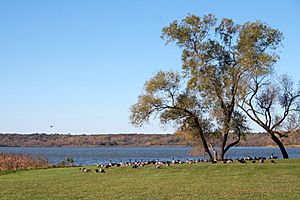Lake Wingra facts for kids
Quick facts for kids Lake Wingra |
|
|---|---|
 |
|
| Location | Madison, Wisconsin |
| Coordinates | 43°3′13″N 89°25′11″W / 43.05361°N 89.41972°W |
| Basin countries | United States |
| Surface area | 1.3 km2 (1 sq mi) |
| Average depth | 2.7 m (9 ft) |
| Max. depth | 4.3 metres (14 ft) |
| Water volume | 6,000,000 m3 (210,000,000 cu ft) |
| Shore length1 | 5.9 km (4 mi) |
| Frozen | about 120 days a year |
| 1 Shore length is not a well-defined measure. | |
Lake Wingra is a small lake found right inside Madison, Wisconsin. It is the smallest of five main lakes in Dane County. These lakes all drain into the Yahara River. Lake Wingra is special because it is surrounded by the University of Wisconsin–Madison Arboretum on its south and west sides. The rest of its shoreline is part of the City of Madison.
Many people enjoy fishing in Lake Wingra. It is especially known for large fish called muskellunge that appear in spring. You can find fun places like the Henry Vilas Zoo, Wingra Boats, Wingra Park, and Edgewood College along the northern shore. Most of the land around the lake is open to the public.
What is the History of Lake Wingra?
Long ago, Native Americans lived around Lake Wingra. They used the land a lot. The lake's name, Wingra, comes from the Ho-Chunk Nation's word for "duck."
In the past, Lake Wingra was a very healthy place for plants and animals. It got a lot of its water from underground springs. This water flowed into the lake and then through Wingra Creek to Lake Monona. From there, it joined the Yahara River, which is part of the Upper Rock River. The Rock River eventually flows into the Mississippi River.
Over the last 200 years, people have used the lake and its surrounding area differently. Now, only a few of the original springs still feed the lake. Much more of the lake's water now comes from surface runoff. This runoff can carry pollution from chemicals and other things.
What Challenges Does Lake Wingra Face?
Like other lakes in the Yahara chain (such as Mendota, Monona, Waubesa, and Kegonsa), Lake Wingra faces several problems.
- It has harmful pollutants like mercury and PCBs.
- The water can get too warm.
- Dirt and sand build up at the bottom (this is called sedimentation).
- There are many non-native plants and animals that don't belong there.
- People use the lake a lot for fun activities.
- Too many nutrients like nitrogen and phosphorus enter the water.
In the past, people did not manage stormwater well around Lake Wingra. Storm drains often sent water directly into the lake. Also, waste from the zoo sometimes flowed into the lake. The City of Madison has fixed the zoo waste problem.
Now, stormwater is often sent to special ponds called holding and settling ponds. These ponds slow down the water and trap pollutants before they reach the lake. However, these ponds can still contain different kinds of pollution. This includes chemicals like PAHs and heavy metals.
How Are People Helping Lake Wingra?
People are working to make Lake Wingra healthier again. So far, these efforts have been small projects. They are like tests to see what works best.
For example, the Wisconsin Department of Natural Resources tried removing non-native carp from the lake in 2006 and 2007. Carp can stir up the lake bottom and make the water cloudy.
The USGS also had a project in 2007. They tested how well two rain gardens worked near Edgewood College. Rain gardens help soak up rainwater and keep it from running into the lake. They hope this will make rain gardens even better at protecting the lake.



